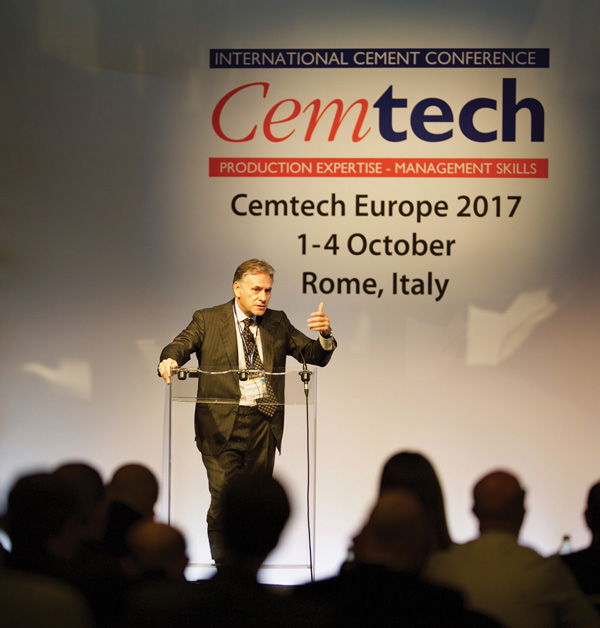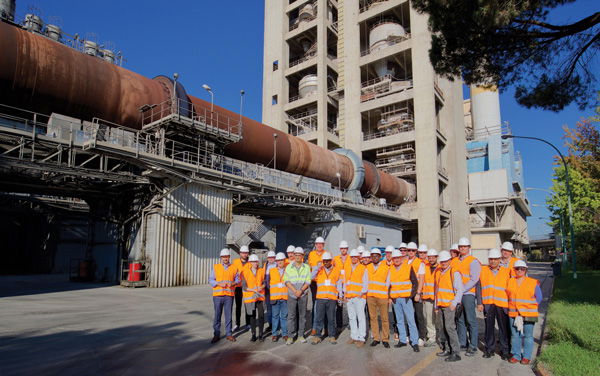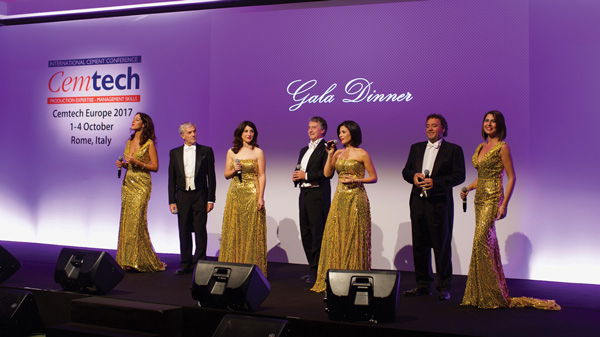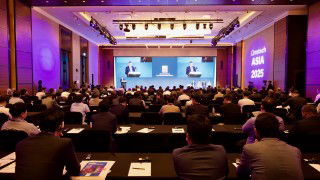On 1-4 October 2017, representatives from 40 nations gathered in Rome for Cemtech’s annual European cement conference and exhibition. Cement producers, equipment suppliers and other industry stakeholders discussed market and corporate developments with a strong focus on Italy, where the industry is undergoing large structural changes following the acquisition of Italcementi by HeidelbergCement.

Paolo Bossi, CEO of Cementir Italia SpA (Italy),
welcoming delegates to Cemtech Rome 2017
Having welcomed delegates on behalf of the cement industry in Italy, Paolo Bossi, CEO of Cementir Italia SpA (Italy), provided a detailed account of the recent dramatic industry developments. Driven by the collapse in domestic demand in Italy from 48Mt in 2007 to 18Mt in 2016, the industry is attempting to scale down capacity and consolidate the fragmented sector where there are still over 20 players in the market. With overcapacity estimated at 15Mta, consolidation is crucial to restore balance and return to profitability.
Cementir tried to play a leading role in domestic consolidation and in 2016 acquired the operations of Sacci. However, explained Mr Bossi, when further efforts to acquire other smaller players were unsuccessful, the company decided to exit its home market and sell its 6.3Mta operation to HeidelbergCement’s subsidiary, Italcementi, for EUR315m.
Cementir, which now only generates 10 per cent of its revenues in Italy, will not leave the cement sector entirely and will continue to build its international portfolio with a specific focus on white cement, where the company is the global leader, confirmed Mr Bossi.

Dr Giuseppe Schlitzer, CEO of Italy’s cement association, AITEC,
expects Italian cement demand to return to 25Mta in the long term
John Fraser-Andrews, Global Equity Head of Building Materials, HSBC Bank Plc (UK), presented his latest scenarios for global cement demand, with a positive three per cent growth forecast for the US and Europe, backed up in part by a recovery in France. He expects a slower expansion of around 0.7 per cent in the rest of the world.
In terms of global corporate trends, Jean-Christophe Lefèvre-Moulenq, CM-CIC Market Solutions (France), provided a comprehensive history of recent merger and acquisition (M&A) trends. He sees CRH as being in pole position for future acquisitions due to its high levels of free cash flow, followed by HeidelbergCement. On the other hand, Cemex “will have to make a move if it wishes to continue existing,” he argued. One possible deal could be a merger between Cemex and Argos, which would create a coherent leader in the Americas with 120Mta of capacity.
Trade in the Mediterranean was the focus for Sylvie Doutres, DSG Consultants (France), who noted a decrease in overall exports of cement and clinker for the Euro-Med exporting countries in 2016, followed by an expansion in 2017, led by Turkey, Portugal and Morocco, with North America and Africa the key destination markets.
Sustainability
A trio of presentations focussed on the role of cement in society and the performance of the industry with respect to carbon emissions and other sustainability benchmarks. Emir Adiguzel, CEO of HC Trading (Germany), highlighted the need for the cement industry, which is seen as a polluter, to improve its global image as well as address climate change and its impacts on a global scale.
The performance of the industry was analysed by Jim O’Brien who explained that the leading cement producers achieved a 15-20 per cent specific net CO2 reduction between 1990 and 2016 (equivalent to a 0.6-0.8 per cent reduction per year). At this rate, a further 7-10 per cent reduction will be achieved by 2030, placing the industry on track to achieve its targets, as set out in the Low Carbon Technology Partnerships Initiative (LCTPi).
However, according to Peter Hoddinott (UK), previously a senior executive with Lafarge, the biggest future gains will need to be made down the chain from clinker production in concrete construction and buildings. The cement industry contributes around five per cent of global man-made emissions, but these are in fact dwarfed by those of buildings and transportation. These are the areas where it will be possible to make the biggest savings in CO2 emissions going forward, especially given the pressures of population growth and urbanisation.

Cemtech delegates had the opportunity to visit Italcementi’s 1.5Mta Colleferro works near Rome
Alternative fuels
Technologies relating to alternative fuels (AFs) formed the core of the conference’s technical proceedings. Daniele Gizzi, AITEC (Italy), reviewed AF utilisation in Italy, where the dominant wastes are RDF, followed by plastics and tyres, then dried sewage sludge. However, with a current thermal substitution rate (TSR) of 16.5 per cent (based on a study by Ecofys in 2017), Italy has the potential to raise its TSR to 40 per cent in the medium term.
AF preparation was the focus of Daniel Wresnik’s presentation who introduced UNTHA’s single-step, mobile shredding system. It can produce solid recovered fuel (SRF) at fractions as fine as 40mm and move to the source of the fuel for additional flexibility.
Brian Smith, N+P Alternative Fuels (UK), described a successful trial of Subcoal, a pelletised high-grade SRF. Subcoal pellets were ground with coal in a Loesche vertical roller mill at Vassiliko Cement in Cyprus at a substitution rate of 10 per cent with no negative impact on clinker quality.
Joel Maia, FCT Combustion GmbH (Germany), reviewed the principles of AF combustion, considerations for AF injection in the calciner versus the kiln burner, and issues surrounding the sulphur and chlorine cycles. Francisco Leitão, Cimpor (Portugal), described the innovation of an AF waste pre-drying system at the company’s Souselas plant, where the TSR is 33.4 per cent. The moist RDF/MSW passes through a 12m conveyor equipped with porous polyester and is dried with hot air from the cooler’s bag filter fan exit. With the new installation, the RDF feed to the main kiln burner was increased from 2.5 to 7tph, while moisture is reduced from 40 to 15 per cent.
Technical advances
Roberto Fedi of Teamnetwork Srl (Italy) presented an important case study from Italcementi’s Rezzato cement plant, demonstrating the potential of an SCR technology, already commonly used outside the cement industry, to achieve a NOx emission limit of 200mg/Nm3 at 10 per cent O2. Mr Fedi argued that SCR technology has advantages over SNCR systems and will become more applicable as NOx limits become more stringent.
Guido Ceccherelli, Ecospray (Italy), described a new ‘hybrid’ ESP upgrade solution: instead of a typical ESP conversion to baghouse, the existing ESP is retrofitted with the embedding of a layer of ‘wall flow’ filtering elements, capable of working at temperatures of over 600˚C. The ESP continues to work as the primary separator, while the new filter elements lower dust elements downstream of the ESP to a level equal to 2-3mg/Nm3. The hybrid unit requires no energy for the gas cooling stage that would normally be required by the baghouse alternative.
Extended programme
Cemtech’s extended programme featured a special break-out seminar led by Thierry Bogaert (France), who introduced participants to the concept of industrial architecture and its role in enhancing the visual impact of cement plants.
The Cemtech plant tour was to Italcementi’s 1.5Mta Colleferro works, where environmental improvements have included the installation of an SNCR system for the non-catalytic reduction of NOx emissions as well as continuous emissions monitoring system (CEMS).

A gala dinner rounded off proceedings
The next Cemtech will be held in Dubai, UAE, on 17-20 February 2018.
This article was first published in International Cement Review in December 2017.
